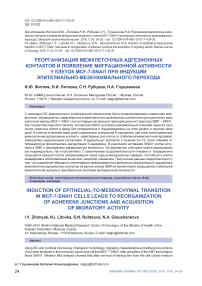Induction of epithelial-to-mesenchymal transition in MCF-7-SNAI1 cells leads to reorganization of adherens junctions and acquisition of migratory activity
Автор: Zhitnyak Irina Y., Litovka Nikita I., Rubtsova Svetlana N., Gloushankova Natalya A.
Журнал: Сибирский онкологический журнал @siboncoj
Рубрика: Лабораторные и экспериментальные исследования
Статья в выпуске: 4 т.17, 2018 года.
Бесплатный доступ
Using DIC and confocal microscopy, changes in morphology, migratory characteristics and adherence junctions (AJs) were analyzed in the mammary carcinoma cell line MCF-7-SNAI1 after activation of the EMT transcription factor SNAI1. Western blot analysis showed that after removal of tetracycline from the cell culture medium expression of SNAI1 reached its peak in 24 hours and then plateaued for 7 days. During the 7 days the cells continued to express E-cadherin; however, tangentialAJs typical for cells with stable cell-cell adhesion, changed into radial AJs. The radial AJs continued to accumulate E-cadherin during 24-72 hours after tetracycline removal. As a result of SNAI1 activation, the cells underwent epithelial-mesenchymal transition (EMT) and became migratory. On a two-dimensional substrate, cells exhibited both individual and collective migration. As the tetracycline washout period progressed, the fraction of the cells capable of migrating through migration chamber membranes increased; on the contrary, cells’ ability to invade an epithelial monolayer decreased. These results demonstrate that retaining a hybrid epithelial/mesenchymal phenotype and accumulation of E-cadherin in AJs during early stages of EMT do not impede disruption of stable cell-cell adhesion and cells’ acquisition of migratory activity.
Epithelial-mesenchymal transition, tumor cells, e-cadherin, migration
Короткий адрес: https://sciup.org/140254194
IDR: 140254194 | DOI: 10.21294/1814-4861-2018-17-4-24-29
Список литературы Induction of epithelial-to-mesenchymal transition in MCF-7-SNAI1 cells leads to reorganization of adherens junctions and acquisition of migratory activity
- Nieto M.A. The snail superfamily of zinc-finger transcription factors. Nat Rev Mol Cell Biol. 2002 Mar; 3(3): 155-66. DOI: 10.1038/nrm757
- Cano A., Pérez-Moreno M.A., Rodrigo I., Locascio A., Blanco M.J., del Barrio M.G., Portillo F., Nieto M.A. The transcription factor Snail controls epithelial mesenchymal transitions by repressing E-cadherin expression. Nat Cell Biol. 2000 Feb; 2(2): 76-83. DOI: 10.1038/35000025
- Batlle E., Sancho E., Francí C., Domínguez D., Monfar M., Baulida J., García De Herreros A. The transcription factor snail is a repressor of E-cadherin gene expression in epithelial tumour cells. Nat Cell Biol. 2000 Feb; 2(2): 84-9. DOI: 10.1038/35000034
- Ikenouchi J., Matsuda M., Furuse M., Tsukita S. Regulation of tight junctions during the epithelium-mesenchyme transition: direct repression of the gene expression of claudins/occludin by Snail. J Cell Sci. 2003 May 15; 116: 1959-67. DOI: 10.1242/jcs.00389
- Beach S., Tang H., Park S., Dhillon A.S., Keller E.T., Kolch W., Yeung K.C. Snail is a repressor of RKIP transcription in metastatic prostate cancer cells. Oncogene. 2008 Apr 3; 27(15): 2243-8. DOI: 10.1038/sj.onc.1210860


